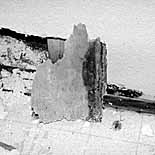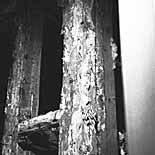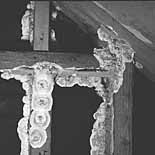






How healthy is your bedroom?
It probably seems just fine. You get a full night's sleep and awake
feeling just fine. I mean, if there was something wrong, you'd know it,
wouldn't you? Maybe not.
by Peter H. Sierck, L.Ac, N.D.
 e all care about the environment: we talk about ocean
pollution, endangered species, hazardous waste, power plants, and hopefully
do something about it. But it is easy to overlook our closest environment,
our home - where we live, where we sleep, where we recuperate and heal.
e all care about the environment: we talk about ocean
pollution, endangered species, hazardous waste, power plants, and hopefully
do something about it. But it is easy to overlook our closest environment,
our home - where we live, where we sleep, where we recuperate and heal.
 Probably the most important place in our home is also
the smallest - our bed. We spend one-third of our life in this one location.
While asleep, the human body is many times more sensitive to environmental
influences than when awake. During the day, the body has a highly active
regulatory mechanism at its disposal to fend off stress. At night, the body,
mind and soul want to relax.
Probably the most important place in our home is also
the smallest - our bed. We spend one-third of our life in this one location.
While asleep, the human body is many times more sensitive to environmental
influences than when awake. During the day, the body has a highly active
regulatory mechanism at its disposal to fend off stress. At night, the body,
mind and soul want to relax.
 At night the body regenerates what was depleted during
the day. Nowhere is the impact of environmental stressors more significant
than in the hours of sleep. Undisturbed relaxation is essential. It is the
basis for health and vitality, two of the most important elements to our
quality of life.
At night the body regenerates what was depleted during
the day. Nowhere is the impact of environmental stressors more significant
than in the hours of sleep. Undisturbed relaxation is essential. It is the
basis for health and vitality, two of the most important elements to our
quality of life.
 We are quick to remedy obvious dangers in our home:
exposed electrical wires, spilled poisons, broken glass, etc. Yet, there
can be unknown dangers lurking that are just as great a risk to our long-term
well-being. Could your home have asbestos or rat poison in an air duct,
mold in the closet or mushrooms in the walls? Are your carpets outgassing
toxic chemicals? Are you exposed to carbon monoxide from a vent pipe or
toxins from a misapplication of pesticides? Are you exposed to radioactivity
from building materials, electric and magnetic fields from an extension
cord jungle or flawed electrical system? Are you exposed to elevated microwave
radiation from a cellular phone towers?
We are quick to remedy obvious dangers in our home:
exposed electrical wires, spilled poisons, broken glass, etc. Yet, there
can be unknown dangers lurking that are just as great a risk to our long-term
well-being. Could your home have asbestos or rat poison in an air duct,
mold in the closet or mushrooms in the walls? Are your carpets outgassing
toxic chemicals? Are you exposed to carbon monoxide from a vent pipe or
toxins from a misapplication of pesticides? Are you exposed to radioactivity
from building materials, electric and magnetic fields from an extension
cord jungle or flawed electrical system? Are you exposed to elevated microwave
radiation from a cellular phone towers?
 All of the above expose us to risks which may not be
visible, noticeable or perceivable, but nevertheless are present. They can
all cause biological effects - no matter what we think or know about them.
All of the above expose us to risks which may not be
visible, noticeable or perceivable, but nevertheless are present. They can
all cause biological effects - no matter what we think or know about them.
Case studies
Here are a few real-life case studies.
- A renowned physician is bedridden with pulmonary distress and eventually
died in his home. His wife, concerned about his inability to recuperate,
had an environmental survey performed. The survey revealed large quantities
of moth balls in all cabinets and a long-term water intrusion problem which
led to moldy carpets and building materials. Naphthalene from the moth balls,
fungal spores, bacteria and dust mites - did this kill him? Maybe not directly,
but without these pathogens he would have had a much better chance of getting
well.
- A graphic artist in San Francisco lived in his home for six years
and had not had a good nights sleep since moving in. He was constantly irritated
and stressed. He always woke up an hour before the alarm clock went off,
no matter what time he went to bed. He could not get back to sleep even
though he was extremely tired. Measurements showed an electric field of
6,000 milliVolt on his body. Turning off the circuit breaker for his bedroom
eliminated strong fields from ungrounded electrical wiring in the wall.
The next morning the young artist did not hear the alarm and overslept for
five hours! His ailments and insomnia dissappeared within weeks
- The children of a San Diego family became ill with recurrent colds
and bacterial infections. An environmental analysis revealed moisture and
microbial problems. The roof of the home had leaked and resulting moisture
problems allowed mold to grow in the wall cavities and in the carpet of
the children's bedrooms. The identification provided adequate diagnosis
to allow the problem to be solved, and the family is on the way to regaining
its health. In addition, the family won a lawsuit against those responsible
for the problem, setting a precedent for financial awards in mold litigation
cases.
 These environmental stress factors are often unnecessary,
easily avoidable and simple to fix. We do not have to renounce civilization
and comfort to be on the safe side, but neither do we need to electrify
our bedrooms like the cockpit of a jet. A little change here or there in
our habits and practices - turning off an appliance or light, a correction
by contractors, a new installation or purchase - can remedy the situation.
These environmental stress factors are often unnecessary,
easily avoidable and simple to fix. We do not have to renounce civilization
and comfort to be on the safe side, but neither do we need to electrify
our bedrooms like the cockpit of a jet. A little change here or there in
our habits and practices - turning off an appliance or light, a correction
by contractors, a new installation or purchase - can remedy the situation.



[Left] The first indication of a problem in this home was
this black streak of mold along the wall.[Right] Removing the carpet and
opening the wall shows extensive mold growth caused by a leaking water pipe.



[Left] Fungus growth inside the wall of this home, fueled by a water
leak, is attacking the structural members. [Right] Mushrooms are great in
salads ... but not in walls. Fungus growth is supported by a leaking roof.
Environmental surveys
 In the previous examples, an environmental home survey
exposed the causes or contributing factors to health problems. These surveys
are often initiated as the result of illness that proves resistant to therapy.
Common signs that a home survey may be in order include:
In the previous examples, an environmental home survey
exposed the causes or contributing factors to health problems. These surveys
are often initiated as the result of illness that proves resistant to therapy.
Common signs that a home survey may be in order include:
- Problems that are resistant to therapy, even after best treatment
available have been tried.
- Relief from symptoms after leaving home for awhile.
- New symptoms after moving into new building, after renovation, installation
of new interior furnishings or after water intrusions.
- The inability to get over colds or flu.
 Once a stressor is identified and removed, the body
has a chance to regain its health. It is important to identify and assess
the factors present in our indoor environment; to act on it, you have to
know it's there.
Once a stressor is identified and removed, the body
has a chance to regain its health. It is important to identify and assess
the factors present in our indoor environment; to act on it, you have to
know it's there.
 Once a survey is conducted, it is important for the
physician to be made aware of the results, as this information will aid
the diagnosis and treatment. Experience by many physicians has shown that
an undisturbed sleeping place is a prerequisite for successful medical treatment.
Once a survey is conducted, it is important for the
physician to be made aware of the results, as this information will aid
the diagnosis and treatment. Experience by many physicians has shown that
an undisturbed sleeping place is a prerequisite for successful medical treatment.
 Children, the elderly, the ill and pregnant women are
most susceptible. Therefore, if indicated, the physician should recommend
an evaluation of the indoor environment.
Children, the elderly, the ill and pregnant women are
most susceptible. Therefore, if indicated, the physician should recommend
an evaluation of the indoor environment.
 An environmental assessment is based on observation,
measurements and testing - not assumptions. Electromagnetic fields, ionizing
radiation, radon gas, formaldehyde, chemicals, carbon monoxide, mold and
bacteria, dust mites and other influences are no longer a mystery, but quantifiable
physical realities. A thorough environmental analysis has to be comprehensive,
and should indicate how to remedy identified problems.
An environmental assessment is based on observation,
measurements and testing - not assumptions. Electromagnetic fields, ionizing
radiation, radon gas, formaldehyde, chemicals, carbon monoxide, mold and
bacteria, dust mites and other influences are no longer a mystery, but quantifiable
physical realities. A thorough environmental analysis has to be comprehensive,
and should indicate how to remedy identified problems.
Building biology
 Indoor environmental science is still in its infancy.
Many aspects have not been researched, and the study of correlations between
possible stressors and their effects are far from complete. But the practical
experience of thousands of home surveys presents a clear message: impressive
results can be produced when bedroom stress is eliminated, the body stabilizes
and medical treatments start to work again.
Indoor environmental science is still in its infancy.
Many aspects have not been researched, and the study of correlations between
possible stressors and their effects are far from complete. But the practical
experience of thousands of home surveys presents a clear message: impressive
results can be produced when bedroom stress is eliminated, the body stabilizes
and medical treatments start to work again.
 Prof. Dr. Schneider, founder of the Institute for Baubiologie
(building biology) and Ecology, has contributed much to this awareness in
the last 25 years. The science of Baubiology is the study of the impact
buildings have on human health, and the application of this knowledge to
the construction of healthy homes and workplaces. Baubiology has led to
ecologically and environmentally safe building methods, and non-toxic and
natural building materials.
Prof. Dr. Schneider, founder of the Institute for Baubiologie
(building biology) and Ecology, has contributed much to this awareness in
the last 25 years. The science of Baubiology is the study of the impact
buildings have on human health, and the application of this knowledge to
the construction of healthy homes and workplaces. Baubiology has led to
ecologically and environmentally safe building methods, and non-toxic and
natural building materials.
Standards
 Governmental standards, where they exist, are primarily
related to industrial work environments. These standards sometimes lack
common sense. For example, a medical treatment room with EEG equipment does
not tolerate more than 2 milliGauss (mG) of magnetic fields and 0.05 milliVolt
(mV) of electric fields to protect the sensitive electronic equipment. However,
industrial standards say we can expose humans to 50,000 mG and 20,000 mV,
respectively, even though we have a pretty sensitive computer between our
ears. These generous industrial limits cannot be transferred from a work
environment to our bedrooms. Sleep is not work, day is not night, and a
bedroom is not an industrial work place.
Governmental standards, where they exist, are primarily
related to industrial work environments. These standards sometimes lack
common sense. For example, a medical treatment room with EEG equipment does
not tolerate more than 2 milliGauss (mG) of magnetic fields and 0.05 milliVolt
(mV) of electric fields to protect the sensitive electronic equipment. However,
industrial standards say we can expose humans to 50,000 mG and 20,000 mV,
respectively, even though we have a pretty sensitive computer between our
ears. These generous industrial limits cannot be transferred from a work
environment to our bedrooms. Sleep is not work, day is not night, and a
bedroom is not an industrial work place.
 But, here we can act in our own best interest. We can
reduce stress factors where they have the most impact - where the biological
risks are the greatest, where improvements are feasible - between our own
four walls! We can become aware and take charge.
But, here we can act in our own best interest. We can
reduce stress factors where they have the most impact - where the biological
risks are the greatest, where improvements are feasible - between our own
four walls! We can become aware and take charge.
 Civilization and progress have side effects. Synthetic
is not an automatic substitute for biological. Fashion is not a justification
for lack of care. Money does not guarantee happiness and ignorance provides
no protection from the consequences of our actions. Similarly, pills and
injections are worthless when fighting building-related illness. The application
of environmental assessment and building biology can be a powerful tool
as part of a medical therapy. Even better, they may prevent illness from
occurring in the first place.
Civilization and progress have side effects. Synthetic
is not an automatic substitute for biological. Fashion is not a justification
for lack of care. Money does not guarantee happiness and ignorance provides
no protection from the consequences of our actions. Similarly, pills and
injections are worthless when fighting building-related illness. The application
of environmental assessment and building biology can be a powerful tool
as part of a medical therapy. Even better, they may prevent illness from
occurring in the first place.

Things you can do to keep your bedroom - and home - healthy
- Take all water intrusions and sewer back-ups seriously and address
them appropriately. According to the Consumer Product Safety Council and
the American Lung Association, 30% to 50% of all structures have damp conditions
which may encourage the growth and buildup of biological pollutants, especially
in warm, moist climates. Inspect attic, windows and basement after heavy
rain for leaks.
- Visible mold growth in a room, closet, behind furniture and underneath
carpet is a sign of contamination. Clean up mold growth (especially a problem
in bathrooms) and check efficiency of exhaust fan.
- Prior to the heating season inspect cold air return and filter element.
Clean and disinfect cold air return if dirty. Change filters and upgrade
to high efficiency filter elements.
- Minimize stray electric fields. Keep electronic devices, such as electric
clocks, telephone answering machines and radios (speakers generate strong
magnetic fields), away from the head of the bed. Use battery operated electric
alarm clock. Use only three-prong (grounded) extension and power cords (shields
electric fields). Turn off electric blankets when going to bed. (strong
magnetic fields).
- Before buying a home inquire about building history, like pesticide
applications, roof leaks, floods and sewer back-ups.
- Be selective when choosing materials for renovation. Specify low emission
materials.
- Specify and require low EMF wiring methods in new construction.
- If your home was built before 1978, have lead testing done before
sanding, scraping or burning off old paint coats.

Peter H. Sierck, a naturopathic physician and licensed acupuncturist,
had conducted more than 1,500 home and offices surveys. He teaches these
subjects in the United States and Germany. He lives in Encinitas, California
and his company, Environmental Testing & Technology, provides testing
and abatement services.

Call to action ... what you can do
 For more information, contact the following organizations
and agencies.
For more information, contact the following organizations
and agencies.
Environmental Health Coalition  235-0281
235-0281
Information on non-toxic pesticide applications
Department of Health Services 338-2068
338-2068
List of local environmental consultants and testing companies
EPA Indoor Air Hotline 800-438-4318/601-688-2457
800-438-4318/601-688-2457
Information and resource on indoor air pollution
EPA Pesticide Hotline  800-858-7378
800-858-7378
24-hour database provides information on health effects and ingredients
of pesticides.
Institute for Baubiology and Ecology 831-461-4371
831-461-4371
Correspondence course on environmentally and ecologically safe building
methods and material.
NEFTA 708-475-3696
708-475-3696
National Electromagnetic Field Testing Association - national referral service.
Air Pollution Control District 694-3362
694-3362
Tests outdoor air in San Diego County. Accepts air pollution complaints
(nuisance).
Cal/OSHA 279-3771
279-3771
Investigates workers safety and health violation. Provides consultations
without fining.








235-0281
338-2068
800-438-4318/601-688-2457
800-858-7378
831-461-4371
708-475-3696
694-3362
279-3771